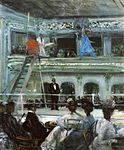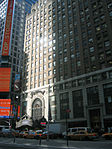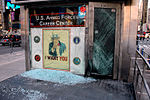3 Times Square

3 Times Square, also known as the Thomson Reuters Building, is a 30-story skyscraper at Times Square in the Midtown Manhattan neighborhood of New York City. Located on Seventh Avenue between 42nd and 43rd Street, the building measures 555 feet (169 m) to its roof and 659 feet (201 m) to its spire. The building was designed by Fox & Fowle and developed by Rudin Management for news-media company Reuters. The site is owned by the New York City Economic Development Corporation, though Rudin and Reuters have a long-term leasehold on the building. Fox & Fowle planned a portion of the facade as a glass curtain wall, though the northeast corner and the south facade are made of masonry. The eastern facade has a curving curtain wall with a wedge atop the southeast corner, as well as a triple-height lobby facing Seventh Avenue. The building contains 855,000 square feet (79,400 m2) of floor space, much of which was originally taken by Reuters. The lowest three stories contain retail space and an entrance to the Times Square subway station. During the 1980s and early 1990s, Park Tower Realty and the Prudential Insurance Company of America had planned to develop a tower for the site as part of a wide-ranging redevelopment of West 42nd Street. After the successful development of the nearby 4 Times Square, Reuters proposed consolidating its headquarters at Times Square in 1997, enlisting Rudin Management as a development partner. Work started in 1998 and the building was completed in 2001, with Reuters occupying the vast majority of the space. The building was jointly owned by Reuters and Rudin for two decades, and a renovation of the interior was announced in 2021.
Excerpt from the Wikipedia article 3 Times Square (License: CC BY-SA 3.0, Authors, Images).3 Times Square
7th Avenue, New York Manhattan
Geographical coordinates (GPS) Address External links Nearby Places Show on map
Geographical coordinates (GPS)
| Latitude | Longitude |
|---|---|
| N 40.756666666667 ° | E -73.986944444444 ° |
Address
3 Times Square (Thompson Reuters Building)
7th Avenue 3
10036 New York, Manhattan
New York, United States
Open on Google Maps










